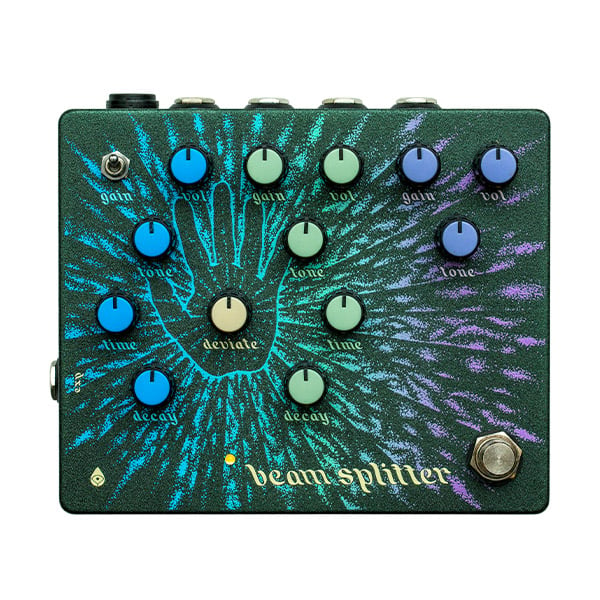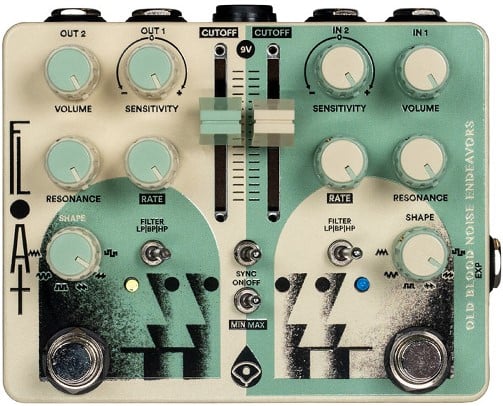Old Blood Noise Beam Splitter Automatic Triple Tracker Distortion Pedal Overview
The Beam Splitter is a single pedal meant to create a massive sound. It is three different takes on overdrive, voiced to work together perfectly. Two of them can be delayed in time, and all three can be run in parallel or split out to three separate sources.
Beam Splitter takes a mono input and makes it wildly bigger than before.
Things stretch in time and compress in dynamics, and a rich harmonic wash is achieved without sacrificing clarity.
• Triple tracking overdrive/distortion pedal
• 3 different parallel drive/distortion sections with individual gain and volume controls and adjustable delay and individual outputs
o Purple – hard clipping distortion – the pedal’s core gain sound
o Green – soft or hard clipping overdrive with the light and bright sound
o Blue - transistor Overdrive - most neutral and reactive with a medium gain range
• Offers triple-tracked drive tones with impressions of flanging, chorusing or broken vibrato, depending on the settings
• Individually adjustable delay time on Green and Blue distortion sections
• Feedback controls for Green and Blue distortion sections to add intense filtering or trailing delays depending on Time setting
• Deviate Control for adjusting randomness of delay time variation in Blue and Green drive sections – for a more realistic sense of doubled players
• EXP input – for controlling Deviate knob remotely
• Relay bypass switching
• Made in the USA
• Powered by 9V DC PSU
o (centre -, 2.1 mm, 150 mA current draw)
We’re not trying to be philosophical here. Like, literally, what is a big sound? To be washed in sound, does it have to be one big sound, or will a number of small sounds do the trick? To create a wall of sound, same question, but also how does it stay solid, we mean to say how can sound waves make a wall, and is it just a moment in time; will it always crash down? While we’re at it, what’s the difference between sound waves and light waves?
Probably something sciency, which is beyond our purview here, and we’re getting ahead or ourselves anyway.
Why record your guitar thrice when Beam Splitter exists?
Beam Splitter is best seen in three sections - Purple, Green and Blue.
• Purple is a hard-clipping distortion that can be seen as the core gain sound of Beam Splitter.
Of Beam Splitter’s three gain sections, it is arguably the heaviest and most compressed. It has three controls, identified by their purple knobs and labels – Gain, Volume and Tone.
• Green is an overdrive with both soft and hard clipping. It is the lightest and brightest of the three gain sections in Beam Splitter. Also featuring Gain, Volume controls the green gain circuit features a Time knob, which sets the delay time, up to 125 sections. When blended in parallel with the other drives, this delay time can create anything from tight comb filters to loose doubling delays to short slapback.
Additionally, there is a Decay knob, which sets the feedback of the delay, from one repeat up to many repeats trailing off. In comb filter settings this can increase resonance.
• Blue is a transistor Overdrive and the most neutral and reactive of the three gain circuits, with a gain range somewhere in the middle. Its Gain switch sets the amount of breakup. In the down setting, it is less overdriven, with less compression in the mids and highs. In the up setting, it is more overdriven and aggressive.
It also boasts Time and Decay controls, on top of the Tone and Volume knobs and gain switch.
The pedal’s Deviate control is a shared knob that sets the amount of random variation in the delay time of the Blue and Green drive sections. The more it is turned up, the farther their delay times can deviate, and the faster those deviations happen. When at zero, the delay times are fixed, above zero, each Time knob sets that sections delay time.
Deviate intends to create a more realistic sense of doubled players, with random variations in timing as if you were playing to the track twice. It can also give the impression of flanging, chorusing or broken vibrato, depending on the settings.
The Expression jack is used to externally control the Deviate knob using a TRS expression devices with standard polarity and tip connected to the wiper.
Beam Splitter has a mono input. From there the signal goes out to Purple, Green and Blue drive sections in parallel. If only plugged into the Purple Out Jack, all three sections will join in parallel mono at that Output.
Green and Blue can each be broken off into their own output by plugging into the corresponding Out jacks.
In this way you can have a full ‘trereo’ setup (We’re being told trereo is not a word, but we think you and us all know it is.)


























